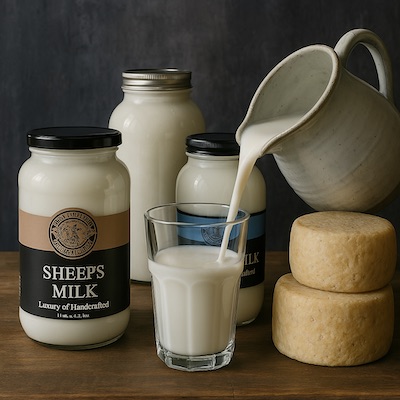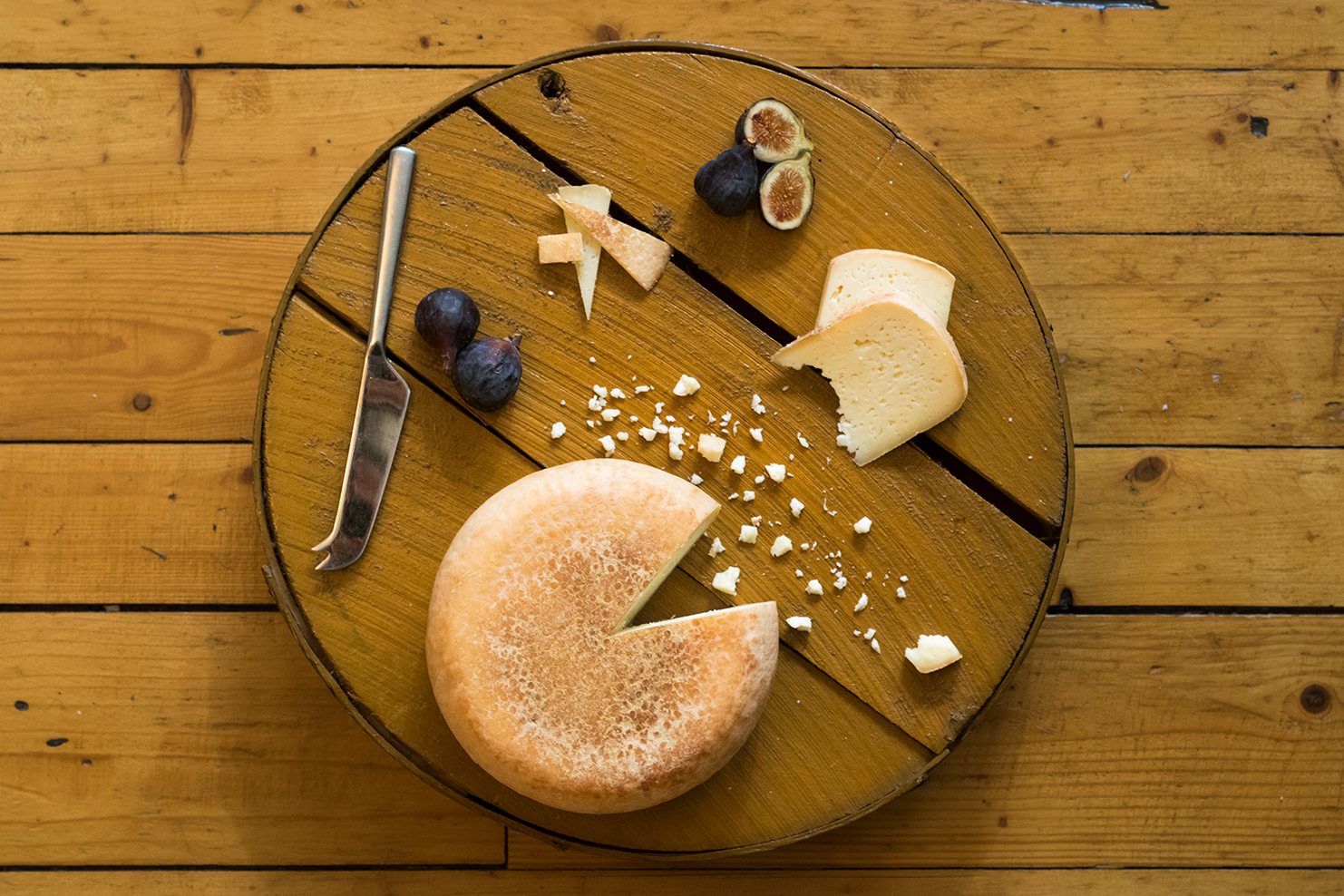When it comes to enjoying cheese at its best, knowing how to store cheese properly is essential.
There is nothing quite like bringing home a well-aged cheese from the farm shop. Aged cheeses have spent weeks, months, or even years developing their unique flavors and textures, and they continue to evolve after you purchase them. Proper cheese storage is crucial for maintaining flavor and freshness – it preserves the cheese’s original characteristics and prevents it from drying out, growing unwanted mold, or absorbing fridge odors. Unlike many foods, cheese is a living product (especially artisan-aged cheeses), so how you care for it at home can significantly impact its taste. Key factors include temperature, humidity, air circulation, and proper wrapping. By understanding these factors and the specific needs of pecorino and caciotta, you’ll ensure your cheeses remain delicious from the first slice to the last.
Pecorino: The Hard-Aged Sheep’s Milk Cheese
Pecorino is a family of Italian cheeses made from sheep’s milk (the name comes from pecora, Italian for sheep) and is typically aged into a firm or hard texture. Varieties like Pecorino Romano are often aged 8–12 months or more, developing a dry, crumbly texture and bold, salty flavor. This lengthy aging means pecorino has low moisture content and a dense structure. The good news is that hard-aged cheeses, like pecorino, are naturally long-lasting because their original purpose was to preserve milk for extended periods. When stored correctly in a cool environment, pecorino can last several weeks or months without spoiling. Its robustness makes it one of the more forgiving cheeses to care for.
Caciotta: The Young Semi-Soft Cheese
Caciotta (pronounced ka-CHO-tah) is a charming traditional cheese from Italy that is quite different from pecorino. In local dialect, caciotta basically means “small cheese,” hinting at its typical size and humble, farmhouse origins. Caciotta is usually made in small wheels and is only aged for a short time, often around one to two months at most, sometimes just a few weeks, depending on the variety. (One Italian producer notes an aging period of roughly 30–40 days for their caciotta.)
Because it is much younger, caciotta has a semi-soft, creamy texture with a higher moisture content. The interior paste is pale (white to light yellow) and often dotted with small irregular holes, and the flavor is mild, fresh, and milky – you can taste the milk’s sweetness, sometimes with a slight tang. This approachable taste and texture make caciotta a delightful table cheese, but they also mean it’s more perishable than a long-aged cheese.
Ideal Storage Conditions: Temperature and Humidity
Cheese is best kept cool and moist, like in an old-fashioned cheese cave. The ideal temperature range for most aged cheeses is around 4–10 °C (39–50 °F). Your refrigerator is the most convenient tool to achieve this, but a fridge’s main compartment can be a bit too cold and dry for cheese (typically ~34–38°F). That’s why the vegetable crisper drawer is often recommended – it’s slightly warmer and more humid, providing gentler conditions for cheese storage. If your fridge has a meat or cheese drawer with adjustable humidity, that’s even better. Set it to a higher humidity to keep cheeses from drying out.
Humidity is key: too little humidity and cheese will dehydrate (you’ll see hard edges, cracking, or brittleness). Too much humidity without airflow, and cheese can become soggy or grow unwelcome mold. A balance is important. For most aged cheeses, you want a mildly damp environment – around 70%-85 % relative humidity is ideal, similar to a cave. In practical terms, wrapping your cheese and placing it in a drawer or container usually achieves this balance by trapping some moisture close to the cheese while still allowing it to breathe.
It’s generally not recommended to freeze fine-aged cheeses like pecorino or caciotta. Freezing can form ice crystals in the cheese that disrupt its texture, often making it mealy or crumbly, and can also mute flavors. Only consider freezing cheese as a last resort, for instance. If you have a large surplus of pecorino that you plan to use later for cooking (grating into cooked dishes). If you do freeze a hard cheese, wrap it very tightly to prevent freezer burn and thaw it slowly in the refrigerator to reduce texture damage. But to enjoy these cheeses at their best quality, keep them in the fridge, not the freezer.
Proper Wrapping: Choosing the Right Materials
One of the most critical steps in caring for your cheese is how you wrap it. The goal of wrapping is twofold: to prevent the cheese from drying out, but also to allow it to breathe. Cheeses are emitting gases and moisture as they continue to age; if you seal them up too tightly, you trap all that moisture (leading to surface slime or mold), and if you leave them unwrapped, they’ll desiccate and absorb flavors from the fridge. Here are the best options for wrapping aged cheeses:
- Cheese Paper: This specialty two-ply paper is designed just for cheese storage. It has a waxy and porous side, creating a perfect balance of protecting the cheese while allowing it to respire. Cheese paper lets excess humidity escape but still keeps the cheese sufficiently moist. Artisanal cheesemakers often considered it to be the gold standard for wrapping artisan cheeses. Cheese paper is especially beneficial for hard and semi-hard cheeses like Pecorino, Gouda, Cheddar, etc., which can last long with this method. Wrap the cheese snugly, then seal the paper with a piece of tape or a rubber band as needed.
- Wax or Parchment Paper (Baking Paper): If you don’t have official cheese paper, parchment paper from your kitchen is a great alternative that mimics the effect. It’s also a cellulose-based paper that offers some breathability. Wrap the cheese in parchment (you may need to double-lay it if it’s thin), then tape it closed or put the wrapped cheese in a loose plastic bag. Many cheesemongers recommend this combo: wrap in parchment, then loosely over-wrap with plastic wrap or foil. The parchment acts as a breathable layer touching the cheese. The secondary covering helps prevent the cheese from drying out. For instance, with Parmesan (similar to pecorino), one storage tip is to wrap it in wax/parchment paper and then in aluminum foil, replacing the paper each time you unwrap for a fresh piece. This keeps the cheese tasting fresh longer.
- Beeswax Wraps: Beeswax-coated cloth wraps have become a popular, eco-friendly storage solution that works well for cheese. These pieces of cotton fabric infused with beeswax (and sometimes pine resin and oils) make the cloth pliable and slightly adhesive. You can press them around a piece of cheese. The warmth of your hands helps mold the wrap to seal. Beeswax wraps create a natural, breathable barrier – they keep moisture in, but also let the cheese breathe like cheese paper. They are reusable and can simply be washed and used again for months.
- Cheese Bags: Some companies offer ready-to-use cheese storage bags made of similar material to cheese paper. These bags can be convenient—simply slip the cheese in and fold over the top. They are designed to maintain the proper humidity and are breathable. These bags are a nice tool if you find cheese paper sheets a hassle.
- Plastic Containers (Boxes): Generally, for aged cheeses like pecorino and caciotta, you don’t want to lock them in an airtight plastic container for long-term storage, as this traps moisture. However, one can use a container in combination with the above wraps. For example, you might wrap your cheese in parchment or beeswax. Then place it in a loosely closed Tupperware or a plastic box with the lid just lightly on. The container will create a little humid chamber that protects the cheese from the harsh, dry air of the fridge.
Meanwhile, the wrap around the cheese prevents direct contact and condensation. Do not seal it completely airtight; air circulation is crucial to avoid condensation. A fully closed container is helpful in cases with very fresh cheeses (feta in brine, fresh mozzarella, etc.) or gooey cheeses. As Jones Family Farm notes, an airtight container is best to contain their moisture in those instances. But think more like a cheese dome or box that can breathe a bit for our aged cheeses. If you have multiple cheeses, you can even dedicate one container as your “cheese box” in the fridge, separating cheeses from other foods (this also prevents strong-smelling foods from flavoring your cheese). Just line it with a paper towel or dry cloth to absorb any excess moisture.
What about plain plastic wrap? In a pinch, yes, you can wrap cheese in plastic cling film – and most grocery-bought cheeses do come in plastic. But it’s widely considered the worst way to store a nice cheese if left long-term. Plastic wrap completely seals the cheese (no airflow) and can promote moisture build-up, which leads to off flavors and molds. It can also impart a plastic taste to the cheese over time.
If you must use plastic, use it only for a short period or as an outer layer over parchment. Always use a fresh piece of plastic wrap each time. Never re-wrap cheese in the same cling film that’s already moist or oily from a previous use. That old wrap can be a breeding ground for bacteria. So while a day or two in plastic won’t ruin a hard cheese, try to transfer it to better wrapping as soon as possible for longer storage.
What to Avoid When Storing Cheese
Just as important as the dos are the don’ts. To keep your pecorino and caciotta in top shape, avoid these common mistakes:
- Don’t Suffocate Cheese in Airtight Plastic – Locking cheese up too tightly is problematic. Cheese needs to breathe. If you see water beads inside a container or under plastic with the cheese, that’s a red flag. Let it air out and switch to a breathable wrap.
- Don’t Let Cheese Dry Out—This is the opposite issue, but equally important. Never leave cheese unwrapped or loosely covered for an extended time in the fridge. The cold air will dehydrate it quickly. A telltale sign is hard, cracked edges on a once semi-soft cheese or an overall hardening of a cut face. Once it dries, you lose flavor, and the texture can become unpleasant.
- Avoid Warm Temperatures for Storage—Aside from short periods for serving, cheese should not be stored at room temperature. While very hard cheeses (like aged pecorino) might survive a week in a cool pantry (some people in Italy keep pecorino in a cellar outside the fridge), it’s not ideal for quality or safety. Warmth speeds up microbial growth and can lead to rancidity. Always put your cheeses into the refrigerator after purchase.
- No Direct Freezing—As discussed, freezing is generally to be avoided for quality reasons. When thawed, a frozen pecorino might crumble and lose its nuanced flavor. A frozen caciotta could weep liquid and turn grainy. Only freeze if you accept those trade-offs and plan to cook with the cheese later.
- Keep Away from Strong Odors – Cheese can act like a sponge for aromas. If stored uncovered, it may absorb the smells of other foods in your refrigerator (ever cut cheese that mysteriously smells like last night’s leftovers? It happens). So, don’t store cheese near things like cut onions, garlic, or melons without a barrier. A good wrap and/or a dedicated cheese box can prevent flavor cross-contamination.
- Don’t Store Different Cheeses Together Unwrapped – Each cheese has its own microflora. Storing two cheeses in direct contact or in one wrap can cause them to share molds or flavors. It’s best to wrap each type separately. If you put multiple wrapped cheeses in one container, that’s fine, but they should each be in their own wrapper so they don’t touch and swap microbes.
- Avoid Excess Moisture – This sounds counterintuitive since we emphasize humidity, but you don’t want cheese sitting in water or overly wet conditions. For example, don’t wrap cheese with a soaking wet cloth touching it. Don’t leave it in a puddle of condensation. Too much surface moisture can break down the rind and invite spoilage organisms. The goal is a slightly damp environment, not wet. If you see that your cheese wrap is soggy, replace it. If using a container, dry it out if condensation builds up.
Avoiding these pitfalls will ensure that your cheese has a long and tasty life in your fridge.
Serving and Rewrapping Tips
Proper care for your cheeses continues each time you serve them. When you’re ready to enjoy that pecorino or caciotta, there are a few best practices to ensure maximum flavor and to keep the remaining cheese in good shape:
- Bring to Room Temperature (But Not Too Long): Plan ahead and take the cheese out of the fridge for a bit before serving. Cold temperatures can mute the flavors and firm up the texture too much, especially for a hard cheese. Experts often recommend removing cheese from the fridge about 60 minutes before serving. Being very hard, Pecorino might benefit from a bit longer (up to 2 hours) to really let its aromas bloom. Just keep it covered to prevent drying while it comes to temp.
Caciotta, which is semi-soft, will soften nicely in 20–30 minutes. The difference is noticeable: a pecorino at room temperature tastes more intense and has a creamier mouthfeel than one straight from the fridge. (One tip: Hard cheeses are easier to cut when cold but taste better when warm. You might do any major cutting or grating of pecorino while it’s still chilled. Then let the pieces sit out to come to temperature before eating.) Soft and semi-soft cheeses like caciotta can be cut at room temperature since they’re not too firm.
- Use Clean Tools: Use a clean knife or cutter each time you cut into the cheese. This prevents introducing new bacteria or molds to the cheese. If you used a knife on, say, a blue cheese and then on your caciotta, you might inadvertently seed blue mold into it. So, try to dedicate or rinse knives between different cheeses.
- Cut Only What You Need: Cut off a portion of the cheese for serving and keep the remainder wrapped up, rather than leaving the entire piece unprotected. For example, slice off the amount of pecorino you plan to set on the cheese board or grate onto pasta. Then immediately rewrap and return the rest to the fridge. The same applies to caciotta: cut a wedge to serve and rewrap the rest. This minimizes the time the main piece spends at room temperature (which can age it faster) and limits its exposure to air. If you’re serving over a long period (like a party), you can periodically cut more as needed. Or keep the cheeses under a cheese dome or cover on the table to reduce drying.
- Rewrap Properly After Serving: Once the cheese has been out and you’re done, prepare it for storage again. It’s a good practice to re-wrap the cheese in fresh paper or a wrap. Rather than using the old piece it was in, especially if that piece is greasy or damp. Over a week or two, you might go through a couple of changes of cheese paper – that’s normal. Fresh wrap ensures no microbial build-up and optimal humidity control. As noted earlier, using a fresh piece of wrap after each use helps keep the cheese fresher. If you were using a beeswax wrap, you can wash it (if the manufacturer says it’s washable). Or at least make sure it’s dry and clean before wrapping the cheese again.
- Handling Rinds: For cheeses with an edible natural rind (caciotta often has a thin rind; pecorino might have a hard rind sometimes coated in wax or oil), you can leave the rind on the portion you’re storing. It acts as a barrier. When serving, you might trim the rind off the piece you put out (some rinds aren’t meant to be eaten, like wax or cloth). If you do cut off the rind entirely, you could place a piece of parchment against that newly exposed side when rewrapping to add a little protection.
- Serving Temperature Consideration: Remember that once a cheese has sat out for a couple of hours, any uneaten portion should be considered “served”. It’s been at warmer temps and handled so that it won’t last as long going forward. It’s best not to re-refrigerate a cheese that’s been out for more than 2-3 hours and then serve it to guests again later; it’s better to consume it or use it in cooking soon. But if it was only out for a short time, it can be chilled again. Just avoid repeated big temperature swings; it can promote condensation inside the wrap. If the cheese was out of the fridge for an extended period (say, you forgot it on the counter overnight). Check it carefully for any signs of spoilage before deciding to keep it.
You’ll extend its life by serving it correctly and promptly returning it to proper storage. Think of it as “refreshing” the cheese’s environment after each use. Let it breathe at room temperature for flavor. Then tuck it back into its cozy wrapping so it can rest until next time.
Conclusion: Savor Every Last Bite
Caring for aged cheeses like pecorino and caciotta is not difficult; it just takes a little knowledge and a touch of attentiveness. These cheeses have been on a long journey from milk to aging room to your kitchen, and proper storage is the final step to honor that journey. By keeping them at the right temperature and humidity, wrapping them in breathable materials, and watching out for signs of spoilage, you’ll ensure they stay as delicious as the day you bought them. Remember that pecorino, with its hardiness, will happily grace your pastas and cheese boards for weeks on end, while caciotta asks only that you enjoy it while it’s young and fresh. Treat them well and they will reward you with incredible flavor every time you indulge.
Happy cheese storing, and even happier cheese eating!




